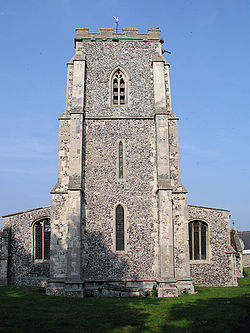Litlington, Cambridgeshire
| Litlington | |
| Cambridgeshire | |
|---|---|
 Litlington, St Catherine | |
| Location | |
| Grid reference: | TL313427 |
| Location: | 52°4’1"N, 0°5’2"W |
| Data | |
| Population: | 813 (2001) |
| Post town: | Royston |
| Postcode: | SG8 |
| Dialling code: | 01763 |
| Local Government | |
| Council: | South Cambridgeshire |
Litlington is a village in Cambridgeshire, to be found some 14 miles southwest of Cambridge and 3 miles northwest of the border town of Royston.
The village is listed as Litlingetona in about 1080 and in the Domesday Book itself as Lidlingtone and Lidlintone. Its current form appears as early as 1242.[1] The name "Litlington" means "Lytel's kin's farmstead".[2]
Village life
Litlington has one remaining public house, The Crown, which opened in the late 19th century. Former pubs include the Robin Hood and Little John, recorded in the early 19th century and closing around 1910. It was named after a local legend that an arrow fired by Robin Hood at the village's chalkpit had grown into a thorn tree. The Seven Stars also opened in the late 19th century. In addition The Horse and Groom was open in the south west corner of the parish, straddling the border with Steeple Morden, in the late 18th century to serve travellers on the turnpike. It closed towards the end of the 20th century.[3]
The village also retains a village shop with post office, a village hall and a football ground with Recreation Centre and play area.[4]
Parish church
The parish church St Catherine consists of a chancel with vestry, aisled and clerestoried nave with south porch and west tower. The earliest parts of the church, including the base of the tower, date from the 13th century. The tower itself is mostly 14th century, and once had a short spire. The church was extensively refurbished at the start of the 19th century, and with the addition of a gallery increased its capacity to around 500.[3]
History
The parish of Litlington has its southern border along the county boundary with Hertfordshire on the Icknield Way, which now follows the A505. Its northern border, with Abington Pigotts, follows a stream, and its western and eastern boundary with Steeple Morden and Bassingbourn follow field boundaries.[3]
The ancient track Ashwell Street runs through the parish just south of the village, and the parish has been occupied continuously for over 2000 years. A Roman villa probably dating from the 2nd century AD and containing 30 rooms was discovered just west of the village in 1829 and was excavated in 1881 and 1913.[3]
Sir William de Notton, a leading politician and judge who died in 1365 held the manor of Litlington in the mid-fourteenth century.
Until the building of the Royston bypass, traffic would frequently go through Litlington to avoid Royston itself. This led to such a volume of traffic that in 1971 the village became the first in Cambridgeshire to introduce a one-way system through the village.[3]
Time Team
"There's A Villa Here Somewhere" was an episode of Time Team first transmitted on 7 November 2010. "A quiet Cambridgeshire village gets the full Time Team treatment as Tony and the digging team hunt for the missing remains of what is believed to be one of Britain's biggest Roman villas." The dig was focused around a copse to the south-west of Anvil Avenue.[5]
Outside links
| ("Wikimedia Commons" has material about Litlington, Cambridgeshire) |
References
- ↑ E. Ekwall, The Concise Oxford Dictionary of English Place-Names; 4th ed. Oxford University Press, 1960; p. 300
- ↑ A. D. Mills (2003). "A Dictionary of British Place-Names". http://www.encyclopedia.com/doc/1O40-Litlington.html.
- ↑ 3.0 3.1 3.2 3.3 3.4 A History of the County of Cambridge and the Isle of Ely, Volume 8
- ↑ Litlington village
- ↑ location
- Litlington Views: 1944 and 1984; photographs by Bill Dumas and Brian Maynard; edited by Peter Griffiths. Royston: Limlow Books, 1993
- History of Abington Pigotts with Litlington: churches & parishes, with the manors; by Magens De Courcy-Ireland. Royston: [the author], 1944